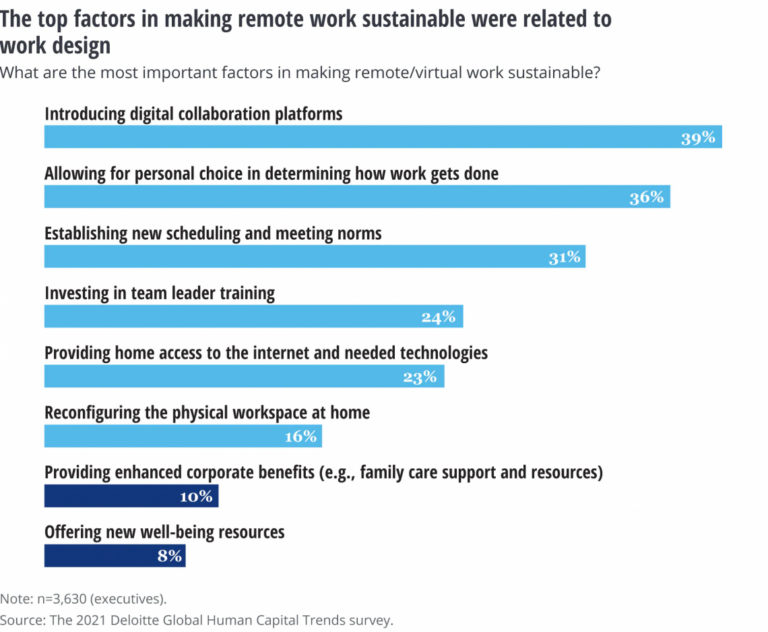In the trending HR World, 25-30% of the global workforce will work remotely in 2021 and 2022. By 2028, 73% of all departments are expected to have remote workers.
HR managers need a robust plan to manage this change in the workforce. Managing the new normal includes knowing and adapting to the latest human resource trends despite any roadblocks.
In this article, we will discuss exactly that. You’ll learn about the top ten human resources trends that will shape the future of managing the remote workforce. Let’s get started!
Digital-first Work Will Be the Norm
The remote workforce is more disconnected from an office and requires businesses to focus on digitalization.
According to Deloitte, executives think introducing digital collaboration platforms (39%) and providing home access to the internet and needed technologies (23%) are the most important factors in sustaining this new way of working and adopting trends.

81% of companies today have at least one application or segment of their infrastructure in the cloud. Also, 13% of enterprises with over 1,000 employees have migrated their entire IT environment to the cloud.
HR managers need to create strategies and implement the latest technologies to make digital-first work a priority.
Responsive Workforce is a Strategic Focus
With employees working from home, some old HR trends and techniques don’t seem valuable now (such as job design, organizational design, scenario planning, etc.). Therefore, these techniques need to be re-optimized to manage the new normal.
Employee Experience is Now a Priority
28% of HR professionals say their top priority is employee experience. The better the employee experience, the more focused they’ll be on work. As a result, you’ll see an improvement in customer experience.
Here are the key benefits of prioritizing employee experience:
- Better Productivity
- Improved satisfaction
- Increased employee loyalty
Since in-person meetings and connections are limited, HR managers need to create additional strategies to enhance employee experience virtually, such as
- Act on employee feedback
- Invest in employee wellness programs
- Encourage open communications
- Offer regular training
- Understand that the times are hard and provide assistance accordingly
Mental Health is Getting More Attention
The pandemic has made us realize the importance of mental health. According to SHRM, 41% of employees feel burnt out, drained, or exhausted from their work. The same report found that 23% of employees report feeling down, depressed, or hopeless often.
Employers understand this. 69% of large employers provided access to mental health support resources in 2020. That number increased to 88% in 2021. The number is further expected to grow to 96% by 2023.
Leading companies like Barclays, Microsoft, Johnson & Johnson, American Express, Adobe, and Netflix have invested heavily in mental health resources. Adobe has gone a step further to assist its employees’ family members 24/7.
Diversity, Equality, and Inclusion Has Become More Important than Ever
Expectations from employers have grown significantly in recent years. DEI (diversity, equality, and inclusion) have become a vital part of HR discussions. Top organizations like Google, Nielsen, and Rolodex are emphasizing DEI now more than ever.
Businesses that focus on DEI are more likely to attract and retain top talent. In fact, McKinsey’s research shows that diverse companies are more likely to outperform their less diverse peers on profitability.
New Regulations Will Limit Employee Monitoring
Last year, more than one out of four companies invested in technology for the first time to passively track and monitor their employees. However, many organizations haven’t created strategies to balance employee privacy, leading to increased employee frustration.
In fact, 50% of employees don’t trust their organization with their data, while 44% never receive any information regarding data collected about them. Going forward, we can expect new regulations at the state and local levels to put limits on what employers can track about their employees.
Employees Will Be Measured Based on Output Rather Than Working Hours
Gone are the days when remote working was optional. Today, employers expect flexible working hours. Even some employers have changed the way they expect employees to work by focusing more on output rather than working hours.
And if it brings results, then why not? For example, Gartner’s 2020 Reimagine HR Employee Survey found that only 36% of employees were high performers at companies with a standard 40-hour workweek. However, organizations that offer flexibility over when, where, and how much employees work sees 55% of their workforce as high performers
Building Skills and Critical Competencies is the Top Priority
Retaining top talent has always been a challenge for employers. Unfortunately, the pandemic has made things even more difficult. To cope with this hurdle, employers will focus on upskilling their employees rather than simply attracting top talent.
In fact, building skills and critical competencies are the top priority for 68% of HR leaders in 2021.
We can expect HR managers to emphasize internal talent development and mobility. It also includes supporting employees with tools and strategies they need to adapt to the uncertainty.
Prepare for the Hybrid Office
Going to the office will likely become optional in the coming years, with companies like Microsoft, Ford, Citigroup Inc., and Google leading the pack. That’s also what your employees expect. Around 52% of the global workforce prefer hybrid work models.

However, HR and IT managers need to re-imagine the workplace to effectively manage the hybrid workforce, including technologies that work both in and out of the office. This will reduce the amount of office space required, thereby mitigating the operational costs for businesses.
Geography Will No Longer Be a Barrier for Talent
The pre-pandemic hiring focused more on recruiting people who could come to the office physically. This limited the talent pool you could attract. However, with remote work, this isn’t a problem.
You can now hire people from across the world without worrying whether they’re ready to relocate. This gives HRs more freedom and businesses a better talent pool for their projects.
Wrapping Up
HRs need to create strategies to effectively manage the remote workforce without affecting the day-to-day activities. These ten trends are highly likely to shape the future of human resources, and managers who are prepared will outdo their peers.
The question is, are you prepared for these trends? We can help you skyrocket your business with the right strategies. Contact Husys’s HR business experts today!




